🟢 🚀
$GOOGL (-3,46 %) +11%
$MC (-0,45 %) +4%
$HNR1 (+0,19 %) +3,4%
$BRK.B (+0,77 %) +3,7%
$8001 (+0,32 %) +2%
🔴🛝
$BTC (-0 %) -15%
$MSFT (-0,32 %) -6%
@Tenbagger2024 I have now done it like this
Postes
547🟢 🚀
$GOOGL (-3,46 %) +11%
$MC (-0,45 %) +4%
$HNR1 (+0,19 %) +3,4%
$BRK.B (+0,77 %) +3,7%
$8001 (+0,32 %) +2%
🔴🛝
$BTC (-0 %) -15%
$MSFT (-0,32 %) -6%
@Tenbagger2024 I have now done it like this
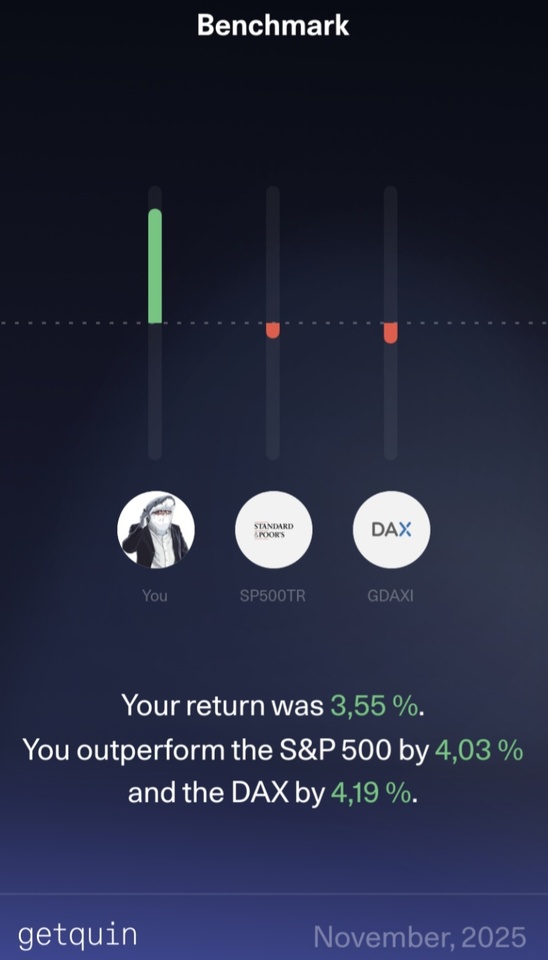

📈 Performance:
S&P500: -0.48%
MSCI World: -0.59%
DAX: -0.51%
Dividend portfolio: +2.91%
My high and low performers in November were (top/flop 3):
🟢 ($LLY (+3,19 %) ) Eli Lilly +24.74%
🟢 ($BATS (-2,66 %) ) British American Tobacco +13.36%
🟢 ($DHL (+0,05 %) ) Deutsche Post +12.64%
🔴 ($TSLA (+1,52 %) ) Tesla -6.57%
🔴 ($HD (+1,29 %) ) Home Depot -7.61%
🔴 ($LMT (+1,74 %) ) Lockheed Martin -16.76%
Dividends:
November 2025: €145.50 + €13.50 gross (Petroleo Brasileiro $PETR4 (+0,38 %) )
November 2024: € 129.78
Change: +12.11%
Sales:
🟥 None
Purchases:
🟩 ($ULVR (-0,71 %) ) Unilever (6 pcs.)
Savings plans:
($CTAS (-0,34 %) ) Cintas (50€)
($MC (-0,45 %) ) LVMH (50€)
($MSFT (-0,32 %) ) Microsoft (25€)
What else has happened?
November was also very quiet. Three weeks of vacation were planned, two of which are already over. I did a few things in and around the house, but otherwise did a lot of nothing and relaxed in preparation for Christmas.
🥅 Goals for 2025:
Deposit of €10,000 and thus a deposit volume in the share portfolio of ~€73,000
Target achievement at the end of November 2025: 82.35%
So I won't reach my personal target. However, a small consolation for me: I will achieve my own and rather unofficial target of € 2400 net dividend.
If you liked the report and would like to read more, feel free to follow me,
If you're not interested, you can keep scrolling or use the block function.
Hi, 3 months ago I bought a $MC (-0,45 %) 3x leverage product. I have now reached a 100% return and the leverage accounts for 2% of my portfolio.
I still see $MC (-0,45 %) still have a good chance of rising into the €680 to €750 range.
Now my question is, how do you see the share in the short term and when would you take chips off the table?
Finally bought one of the shares that had been on my watch list for a long time. Sold the fractional share of $MC (-0,45 %) sold.
Let's wait and see whether investors will soon realize this. And perhaps Buffet or a star investor @Simpson gets involved in some companies.
Dear all, what are your value stocks?
The key figure with the highest stability for the Copart share is the reported profit, which is used below for the valuation. The P/E ratio (price/earnings ratio) calculated from this figure is 25.17, which is 1.79 points below the historical average of 26.96 for the last 10 years. From this perspective, the Copart share appears to be favorably valued.
The fair value of the Copart share is calculated over the 10-year valuation period selected above. The average P/E ratio in this case is 26.96.
Multiplied by the reported earnings per share of USD 1.59 over the last 4 quarters, this results in a fair value of USD 42.87 for the Copart share. The current share price of USD 40.51 is 5.5% below this fair value, which means that the share appears to be slightly undervalued.
The key figure with the highest stability for Chipotle Mexican Grill shares is the operating cash flow, which is used below for the valuation. The KCV (price/cash flow ratio) calculated from this figure is 18.48, which is 12.01 points below the historical average of 30.49 for the last 10 years. From this perspective, the Chipotle Mexican Grill share appears to be favorably valued.
The fair value of the Chipotle Mexican Grill share is calculated over the 10-year valuation period selected above. The average KCV in this case is 30.49.
Multiplied by the operating cash flow per share of USD 1.65 over the last 4 quarters, this results in a fair value of USD 50.31 for the Chipotle Mexican Grill share. The current share price of USD 30.59 is 39.2% below this fair value, which corresponds to an undervaluation of the share.
For the e.l.f. Beauty share, the most stable key figure is the adjusted profit. However, this should not be used for the valuation because the time series is too short for a representative average calculation. The operating cash flow is therefore used for the valuation. The KCV (price/cash flow ratio) calculated from this key figure is 26.51 and therefore 27.97 points below the historical average of 54.48 for the last 5 years. The e.l.f. Beauty share appears to be favorably valued from this perspective.
The calculation of the fair value of the e.l.f. Beauty share is calculated over the 5-year valuation period selected above. The average KCV in this case is 54.48.
Multiplied by the operating cash flow per share of USD 2.89 over the last 4 quarters, the fair value of the e.l.f. Beauty share has a fair value of USD 157.46. The current share price of USD 73.74 is 53.2% below this fair value, which corresponds to a strong undervaluation of the share.
The key figure with the highest stability for the UFP Technologies share is the adjusted profit, which is used below for the valuation. The P/E ratio (price/earnings ratio) calculated from this figure is 22.69, which is 0.72 points above the historical average of 21.97 for the last 10 years. From this perspective, the UFP Technologies share appears to be fairly valued.
The fair value of the UFP Technologies share is calculated over the 10-year valuation period selected above. The average P/E ratio in this case is 21.97.
Multiplied by the adjusted earnings per share of USD 9.82 over the last 4 quarters, this results in a fair value of USD 215.77 for the UFP Technologies share. The current share price of USD 226.11 is 4.8% above this fair value, which means that the share appears to be fairly valued.
The key figure with the highest stability for the Tetra Tech share is the adjusted profit, which is used below for the valuation. The P/E ratio (price/earnings ratio) calculated from this figure is 21.07, which is 2.74 points below the historical average of 23.81 for the last 10 years. From this perspective, the Tetra Tech share appears to be favorably valued.
The fair value of the Tetra Tech share is calculated over the 10-year valuation period selected above. The average P/E ratio in this case is 23.81.
Multiplied by the adjusted earnings per share of USD 1.52 over the last 4 quarters, this results in a fair value of USD 36.19 for the Tetra Tech share. The current share price of USD 32.22 is 11.0% below this fair value, which corresponds to an undervaluation of the share.
The key figure with the highest stability for the LVMH Moet Hennessy L.V. share is the operating cash flow, which is used below for the valuation. The KCV (price/cash flow ratio) calculated from this key figure is 15.32, which is 0.82 points below the historical average of 16.14 for the last 10 years. From this perspective, the LVMH Moet Hennessy L.V. share appears to be favorably valued.
The fair value of the LVMH Moet Hennessy L.V. share is calculated over the 10-year valuation period selected above. The average KCV in this case is 16.14.
Multiplied by the operating cash flow per share of EUR 39.16 over the last 4 quarters, this results in a fair value of EUR 632.04 for the LVMH Moet Hennessy L.V. share. The current share price of EUR 603.20 is 4.6% below this fair value, which means that the share appears to be fairly valued.
( Source share finder ).
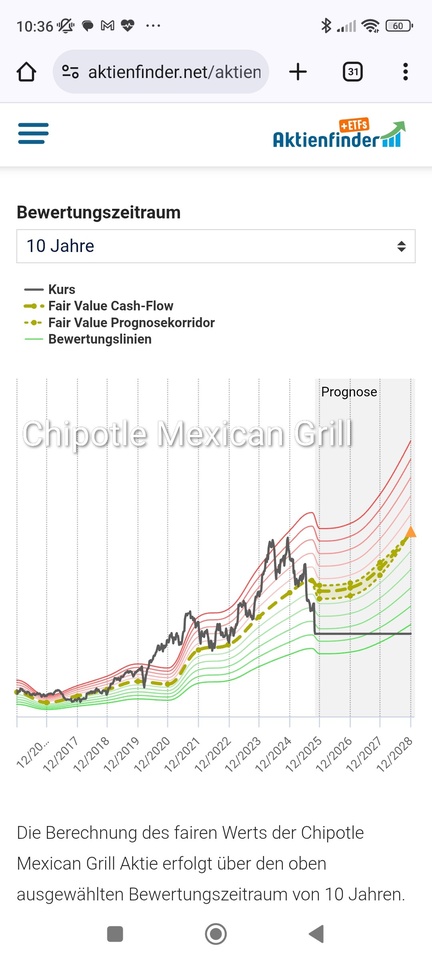
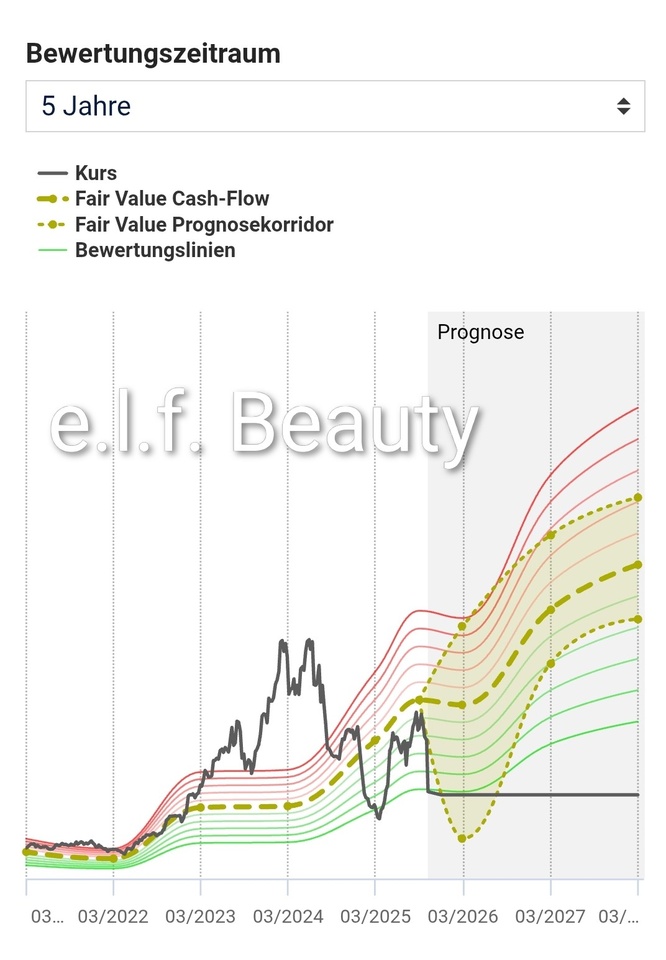
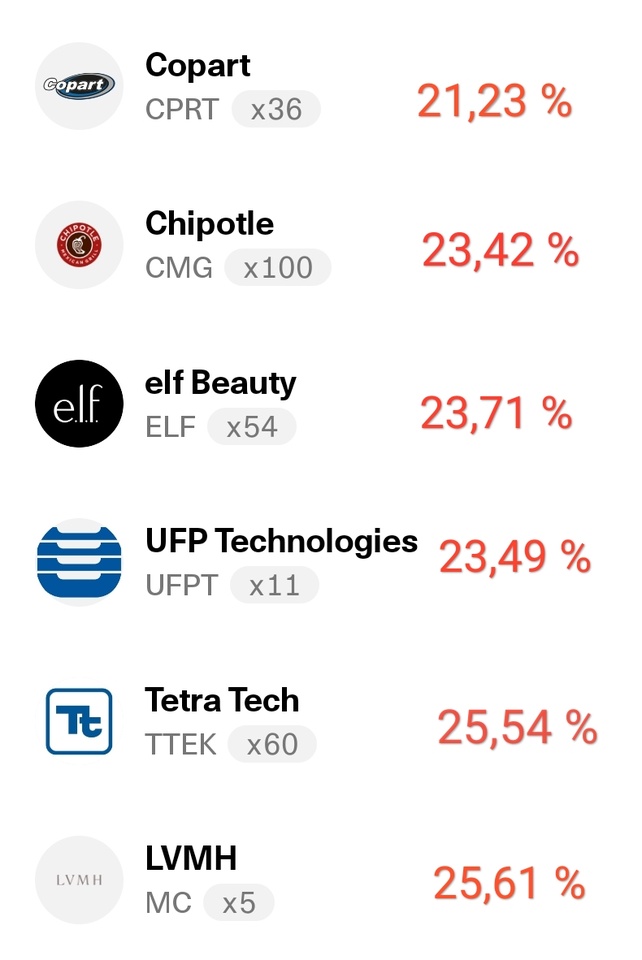
+ 3
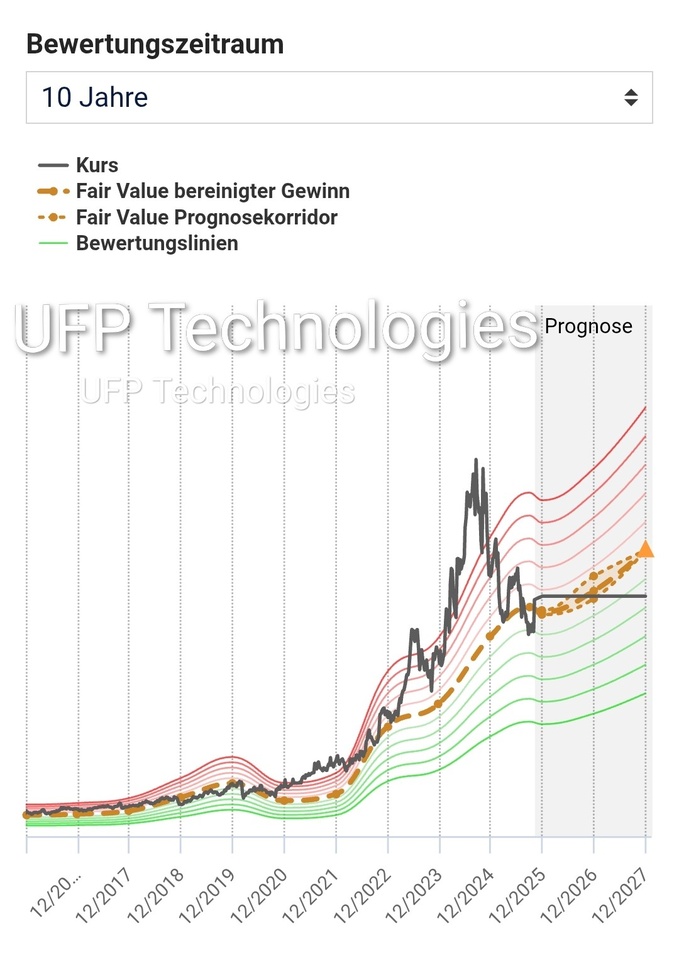
bye bye Louis
currently see no potential here, was in the red for a long time, in the long term there may be a future, but unfortunately not for me at the moment.
Quite cool as a luxury ETF, but I will rather shift the money into other tech companies.
I still have luxury in my portfolio with $RACE (+0,71 %) .
My review of October 2025. Many thoughts and yet no solution.
There's also a question at the end of the article.
📈 Performance:
S&P500: +4.73%
MSCI World: +4.25%
DAX: +0.32%
Dividend portfolio: +1.13%
My high and low performers in October were (top/flop 3):
🟢 ($LLY (+3,19 %) ) Eli Lilly +20.29%
🟢 ($MC (-0,45 %) ) LVMH +17.59%
🟢 ($STAG (-1,29 %) ) STAG Industrial +11.02%
🔴 ($CTAS (-0,34 %) ) Cintas -8.41%
🔴 ($TXN (-1,12 %) ) Texas Insturments -11.09%
🔴 ($RACE (+0,71 %) ) Ferrari -15.71%
Dividends:
October 2025: €126.83
October 2024: € 147.55
Change: -14.04%
Sales:
🟥 None
Purchases:
🟩 ($ULVR (-0,71 %) ) Unilever (8 pcs.)
🟩 ($WM (+2,8 %) ) Waste Management (2 pcs.)
Savings plans:
($CTAS (-0,34 %) ) Cintas (50€)
($MC (-0,45 %) ) LVMH (50€)
($MSFT (-0,32 %) ) Microsoft (25€)
What else has happened?
October was very quiet. Apart from a week's vacation and my birthday, nothing much happened. I used the quiet (and free) time to continue thinking about my nest egg. When do I fill it up and how much? Does it really have to be €10,000? How quickly should this happen or can I just save up slowly? What would be my safe-sleeping amount? Questions upon questions. I have also found many answers. However, I haven't really got any further because I can't make up my mind.
The current situation is as follows: The savings rate on shares will be reduced, and the special payment will not be included in the $XEON (+0,01 %) (i.e. for loan repayments), but will also go into the nest egg. I have set the amount I want to save to €5,000. That would then be done. I'll be rebuilding again from January. Until then, I'm still working out how I can present it well and what I feel comfortable with. I can still save the amount for the loan, as long as I plan a monthly savings amount at some point and don't just use the special payments.
🥅 Goals for 2025:
Deposit of €10,000 and thus a custody account volume in the share portfolio of ~€73,000
Target achievement at the end of October 2025: 77.94%
If everything remains/becomes as planned, I will not reach my personal target. But if I don't change my mind again (which would result in a lower nest egg) or get a windfall for Christmas, then I don't see any more options at the moment.
How would you solve my "problem" with the nest egg? How would you decide?
If you liked the report and would like to read more, feel free to follow me,
If you're not interested, you can keep scrolling or use the block function.

While all about $MC (-0,45 %) and $RMS (-0,16 %) one share is flying under the radar of many investors: Prada $1913 (+1 %) . Thanks to Miu Miu, the company is growing despite the recessionary environment. In recent years, it has achieved 17 % sales growth per year - the best figure in the industry.
Basics about Prada
The Italian fashion group is listed in Hong Kong - which could also be a reason for its favorable valuation. In addition to Miu Miu and Prada, the company also owns other brands. However, these are not relevant for sales. Prada currently accounts for 67% of sales and Miu Miu for a further 32%.
Most of the items are produced in Italy. A small proportion is produced by "selected producers" - a paraphrase for production in low-wage countries such as China. This is the first potential risk for Prada. Made in Italy is probably the most important figurehead, together with the brand history.
The rise of Miu Miu
The brand is the reason for Prada's strong growth. It originates from Prada itself and has been experiencing a sustained boom for years. While it still accounted for 15% of sales in 2018, it now accounts for 32% - and the trend continues to rise. The larger the share of total sales, the greater the impact of Miu Miu's growth on the Group as a whole.
The combination of Prada and Miu Miu is exciting, as Prada can focus on classic and timeless fashion, while Miu Miu is more in tune with the times. The clear demarcation ensures that each brand can remain true to its target group.
This clear brand identity is important for the long-term relevance of a brand. Gucci and Louis Vuitton have been less loyal to their core customers in recent years and have sacrificed long-term brand identity for short-term growth.
Additional growth through the Versace takeover
Even though the management ruled out becoming a fashion holding company similar to LVMH some time ago, Prada took over the Italian fashion label Versace from Capri Holdings this year. $CPRI (-2,58 %) The Versace takeover is to be completed by the end of 2025. Prada paid 1.25 billion euros for the struggling luxury company. The expected Versace turnover for 2025 was 810 million euros. The favorable purchase price is due to the fact that Versace is not profitable and its turnover shrank by around 20% in the previous year.
Versace has become too mainstream in recent years and, like Gucci (part of: $KER (+1,28 %) ), has lost its core clientele. Prada now has the task of returning the company to its roots. In the valuation, I therefore assume that Versace will be slimmed down by 20%. More on this in a moment. Versace is a bargain overall - but only if Prada manages to bring Versace back to its roots.
Competition
In order to better assess the current valuation multiple, I have compared Prada with its most important competitors.
It is immediately apparent that the EBIT margin of 24% is significantly lower than that of Hermès or $MONC (-0,16 %) . This justifies a certain valuation discount - but However, with an EV/EBITDA of 10, Prada is worth around two thirds of Hermès. The multiples are also falling further due to the strong growth.
Prada is currently valued similarly to LVMH, but the valuation is falling much faster. There is also a 3.1% dividend yield. The debt is conservative at 1.25 net debt/EBITDA.
Valuation
The Prada brand is growing organically only slightly. Future growth depends heavily on Miu Miu. I have created a multiple valuation model to better estimate the influence of Miu Miu and Versace.
My assumptions:
I am also of the opinion that the valuation multiple is currently too low. is currently too low. The industry is in crisis and is punishing Prada as well. In addition, the EBIT margin is currently lower. I have therefore created a conservative estimate with a constant multiple and a (for me) realistic model with a multiple increase from 11 to 14.
With multiple increase
Without multiple increase
Even without the increase in the multiple, Prada currently looks attractive. The expected return together with the products make Prada the best luxury stock in my eyes!
Note: The article contains my personal opinion and is not investment advice! The share is in my personal portfolio.
ps: this is my first post. Leave some love or constructive feedback there😘
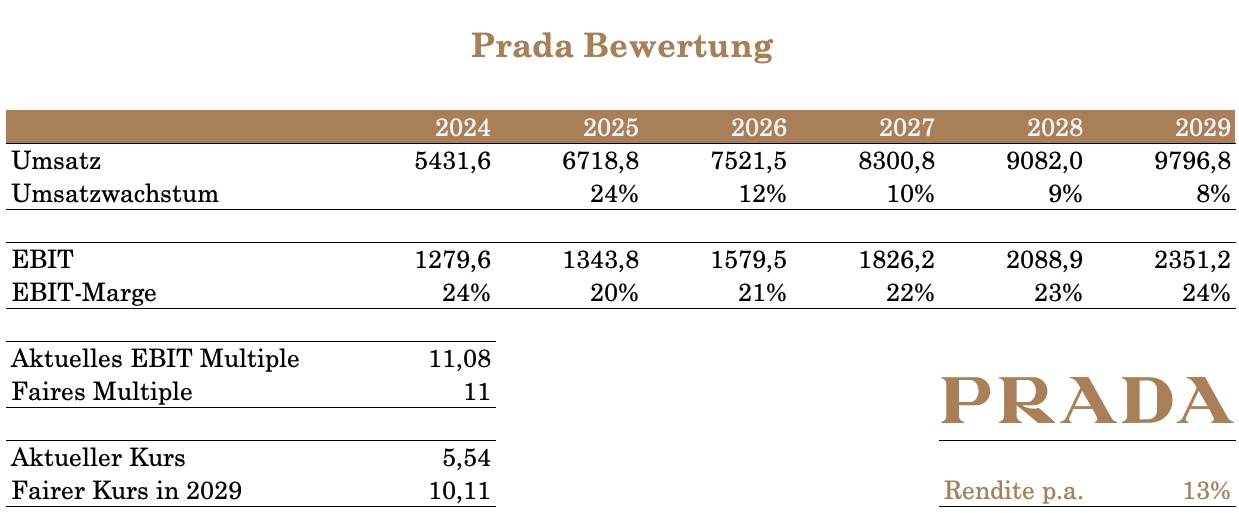
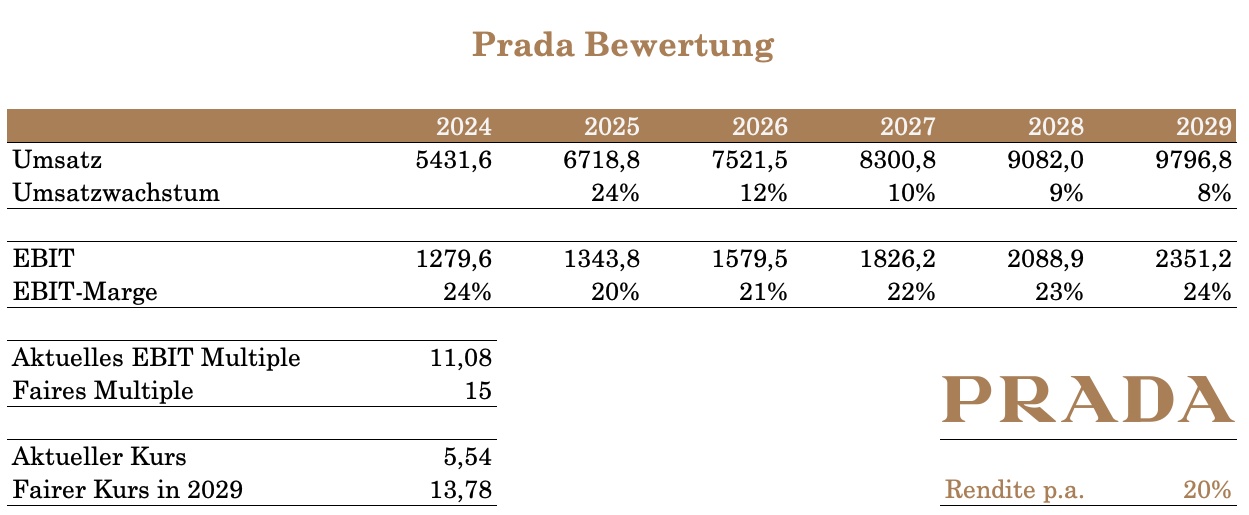


Cash holdings increased.
Latest figures from $MC (-0,45 %) , najaaa
In the end I am satisfied. Standing at just under -40%.
adé, it was nice. 👋🏻 (well, not really, but ok!)
- According to insiders, LVMH is working with Evercore on the possible sale of its stake in the Rihanna co-founded brand
- Fenty Beauty was founded in 2017 together with LVMH subsidiary Kendo Brands launched
- In 2024, the brand generated around $450 million in sales
- Sources value Fenty Beauty at $1-2 billion
Meilleurs créateurs cette semaine